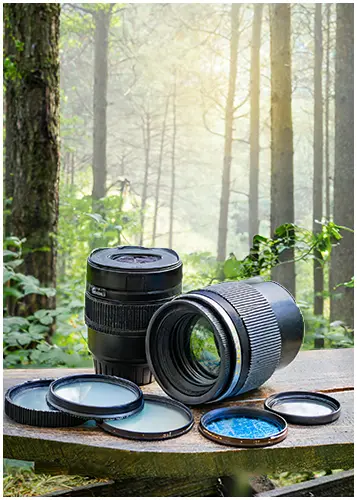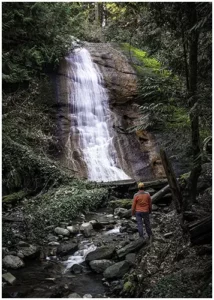
Harness the Power of Light and Shadow in Landscape Photography
In photography, light and shadow are essential for creating captivating photos. It’s important to grasp


Using a ultraviolet filter for a camera lens has been a topic of debate among photographers for years. Some argue that it is necessary for lens protection, while others believe it is unnecessary and may hinder image quality.
Why do I use use a UV filter, as a protective filter! I use one to protect the lens from scratches, dust, dirt, flying rocks, and tree branches. However, dropping the camera or lens can still result in damage to both the protection filter and the lens. Ultimately, the decision to use a UV filter, or type of filter, comes down to personal preference and risk tolerance.
Is the UV filter on my lens at all times? No! a ultraviolet filter is not on my lens at all times, this decision allows me to use my Polarizing filter without doubling up the glass in front of my lens
Over the years of taking photos with various filters for lenses. I've witnessed situations where having a UV filter on your lens has saved the lens, and opposing scenarios where the absence of a ultraviolet filter resulted in needing to replace the lens.
Bob
In the world of photography a UV Filter is like the guardian at the front of your lens. The multi-coated glass filter attachment, like the K&F concept filter, protects your camera from UV light and the lens from environmental damage.
Despite advanced digital cameras boasting built-in UV protection, UV filters, including the skylight filter, continue to be valuable for photographers and enthusiasts. A ultraviolet filter protect your camera lens from dust, moisture, grime, and accidental hits by tree branches ( <– Experience, this is why I’ve mentioned it twice). This helps extend the lifespan of the lens. Don’t you want to protect that expensive lens?
As for the belief that UV filters impair image quality, this depends on the quality of the UV filter itself. High-quality UV filters can maintain image clarity and avoid unwanted artifacts like reflections and ghosting. On the other hand, filters with inferior glass may compromise image sharpness. Hence, the supposed degradation in image quality is a myth if you’re working with a superior ultraviolet filter.
Another common concern is the alleged loss of light and decrease in resolution through UV filters. A good quality filter has little impact on reducing light transmission, despite the theoretical possibility of an additional glass element affecting it. In fact, modern lenses often consist of a complex array of optical elements. Any loss of resolution is often down to grimy or poor-quality filters, making cleanliness and quality key considerations.
UV light, although invisible to the human eye, plays a vital role in photography. Particularly in film photography, UV light can result in a bluish cast and haze. In digital photography, this effect is minimal due to the inherent UV protection in camera sensors and lenses. UV light can affect the white balance and make the image cooler or bluer.
Using a UV filter manipulates how your camera captures environments, particularly those high in UV light. By blocking these wavelengths, UV filters reduce haze and improve clarity. Additionally, as UV filters protect your lens from scratches, dirt, and fingerprints, they can keep your images crisp and clear. So, while UV filters don’t directly enhance images, they help maintain optimal lens condition, contributing indirectly to better photo quality.
When buying a UV filter, start by checking the filter’s diameter to ensure compatibility with your lens. The quality of the glass is also crucial – look for a filter with high-quality, anti-glaring, and anti-scratch properties. The frame’s thickness should be considered when using a filter on a wide-angle lens or with other filters to prevent the vignette effect. Other features to consider are impact resistance, waterproof properties, durability, and ease of cleaning.
Prices of UV filters range from $30 to $200. The price of a filter can vary due to factors such as its diameter (larger filters cost more), the quality of the glass, whether it has multi-coating, its design, and the manufacturer. It’s worth noting that quality comes at a cost. Even moderately priced filters can offer good protection for your camera.
“Investing in a good UV filter is usually cheaper than buying a new camera lens”
Several industry-leading UV filters are known for their efficiency. Some of the best filters on the market are, Hoya, Sigma, Tiffen are my top picks for their remarkable compatibility with digital cameras and film photography. They are what I would call quality filters and at the top for lens protection capability without sacrificing image quality.
Quality UV filters don’t necessarily need to break the bank. Some budget-friendly models aren’t far behind in performance. K&F or Neewer UV filter offers optical excellence coupled with affordability.
A UV filter’s benefits come to the fore in harsh environmental conditions. These include arid, sandy regions like deserts and beaches, where it can protect your lens from dirt and scratches. In rainy weather, a UV filter helps keep your lens dry, though it’s wise to take additional precautions to protect your gear from water damage. When photographing easily smudged objects like children’s hands, UV filters make cleaning a breeze.
Certain situations may call for the removal of your UV filter. If there is bright sunlight, it is best to take photos without the UV filter because it can darken the photos unnecessarily. Similarly, using a flash with a UV filter may cause light to be reflected into your eyes. If you use a telephoto lens, you may not require a UV filter because the lens already provides some protection against UV rays. When using a lens hood, or other filters like a ND filter or a circular polarizing filter. You never want too much glass in front of your lens.
Think about the UV Filter as a shield placed at the front of your lens, standing guard against those invisible UV rays that can dull the brilliance of your photos. Not only does it preserve your lens, but it also ensures that your images come out crisp and clear.
Now, when you’re packing your camera bag for your next adventure, make sure that UV filter is right up front, ready to face the elements. It’s a simple, yet indispensable tool that every photographer, new or seasoned, should have in their arsenal.
So, next time you’re out shooting, remember the UV filter – your secret weapon against UV haze and a front-line defender of your camera lens’s.
UV filters can slightly impact image quality, but it’s usually negligible. In most situations, their primary role is lens protection. High-quality filters are key to minimizing any adverse effects on your photos.
Yes, there are alternatives to glass screw-on filters. Photographers can explore filter systems with square or rectangular filters that slide into holders, offering versatility and avoiding potential vignetting issues associated with screw-on filters.
A UV filter serves as both a protective measure for your lens and a tool that can enhance your images. It blocks UV rays to safeguard your lens while reducing haze, resulting in clearer and more vibrant photos.

In photography, light and shadow are essential for creating captivating photos. It’s important to grasp

Looking to kill off an hour while in Nanaimo, BC? Just a short hop-skip and

Photography can be a fulfilling and enjoyable hobby that brings a creative outlet to your